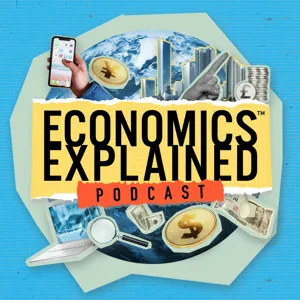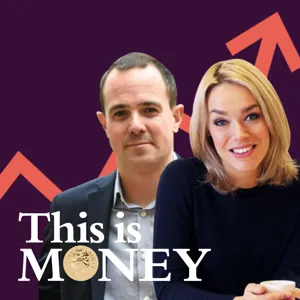Podcast Summary
Navigating the Complex Economy Recovery: Economic recovery is marked by contradictory trends, requiring policymakers to consider human impact and address challenges in employment, inflation, and psychological well-being.
The US economy is experiencing a complex and nuanced recovery from the pandemic, with contradictory trends such as labor shortages and rising wages, inflation concerns, and calls for policy changes regarding unemployment benefits. Economist Betsey Stevenson, a former chief economist of the Department of Labor and member of Obama's Council of Economic Advisors, emphasizes the importance of considering the human impact of economic decisions, including the challenges of working low-wage jobs, fear of the pandemic, and balancing work and family life. The economy has seen significant loss in the past year, leading many unemployed individuals to consider changing occupations or fields. The recovery is ongoing, with challenges in both health and safety, as well as psychological well-being, still present. The economy's future depends on how policymakers address these complex issues and provide opportunities for individuals to improve their lives.
People reevaluating careers due to pandemic: Despite economic uncertainty, people are leaving jobs for better opportunities and work-life balance, indicating optimism for future job market
The pandemic has forced many people to reevaluate their careers and consider making changes, leading to a high number of quits and job transitions. This trend is not due to a lack of employment opportunities, but rather a psychological response to the pandemic and a desire for a better work-life balance. The increase in quits, which is typically seen as a sign of pessimism in economic terms, is actually a sign of optimism during this time as people believe there will be more job opportunities in the future. The data from the April jobs report supports this, showing that the number of people leaving jobs is a significant factor in the lower-than-expected employment numbers. Overall, this moment in the economy is unique and contentious, with differing interpretations of the data and its implications for the labor market.
Economic Shift: Power to the Workers: Record-high quit rates, rising wages, and increased job openings indicate a shift in power towards workers. The pandemic and unemployment benefits have amplified this trend, leading to debates about morality and government support.
The current economic landscape is experiencing a shift in power towards workers, with record-high quit rates, rising wages, and increased job openings. This transition is seen as a sign of policy success by some, while others view it as a risk. The debate hinges on the question of whether it's moral to use the threat of starvation to motivate people to work. With the ongoing pandemic, unemployment benefits have given workers more power, leading some to question if it's time to raise minimum wages. The debate also reveals a divide between those who feel the pandemic is over and those who don't, with varying vaccination rates and concerns about new variants. Ultimately, this period of economic change invites important discussions about worker power, morality, and the role of government in supporting workers during uncertain times.
The slow return to normalcy in the labor market: The pandemic's impact on the labor market is causing a significant reallocation, delaying the full return to pre-pandemic activities due to factors like fear of the delta variant, trauma from essential work, and lack of good job options.
The economic recovery from the pandemic may take longer than expected due to the significant reallocation happening in the labor market. This reallocation, similar to the process of getting remarried after a divorce, takes time. Fear of the delta variant, trauma from essential work, and lack of good job options are some factors contributing to the delay in a full return to pre-pandemic activities. Essential workers, who have been praised for their contributions during the pandemic, are not being treated well in return. The labor market's empathy towards the struggles of workers and the quality of jobs available needs improvement. The pandemic has brought about a shift in people's priorities, making them reconsider their jobs and work conditions. This change, combined with the ongoing fear and trauma, is making the return to normalcy a gradual process.
Impact of Unemployment Insurance on Returning to Work: The pandemic's unemployment insurance debate overlooks individuals' complexities, with minimal discouragement effect and crucial benefits for struggling families, particularly mothers with young children.
People are not interchangeable economic units, but complex individuals with unique circumstances and needs. During the pandemic, unemployment insurance has been a subject of debate, with some arguing it discourages people from returning to work. However, the speaker suggests that the impact might be minimal and that the benefits may be necessary for those struggling to cope with the challenges of the past year. Additionally, the discussion touched upon the impact of childcare on employment, particularly for families with young children. The speaker highlighted a study that showed the employment-population ratio drop for mothers with children accounted for the majority of the decline. Overall, the conversation emphasized the importance of considering the humanity and complexities of individuals when discussing economic policies.
Childcare disruptions impact labor market recovery, especially for women: The pandemic led to a loss of childcare workers, causing many mothers to struggle, potentially leading to permanent changes in how people view child care and living arrangements. Inflation is a current concern due to increased demand exceeding supply, with ongoing implications for the labor market and Federal Reserve's approach.
The role of childcare and its disruptions have significantly impacted the labor market recovery, particularly for women. The pandemic led to a loss of childcare workers, causing many mothers to struggle, and potentially leading to permanent changes in how people view child care and living arrangements. At the same time, inflation is a current concern due to increased demand for goods and services exceeding available supply, resulting in higher prices. The debate continues on whether this is a temporary issue or the beginning of ongoing inflation, with potential implications for the Federal Reserve's approach.
Beliefs and expectations about inflation: People's beliefs and expectations about inflation can influence its occurrence, with media and financial markets shaping these perceptions. Recent supply chain disruptions have caused inflation concerns, but their resolution may ease price pressures.
Beliefs and expectations about inflation can significantly impact its occurrence. The more people believe inflation is coming, the more they may rush to buy goods and services, leading to higher prices and a self-fulfilling prophecy. Conversely, if people believe inflation is under control, they may wait to make purchases, slowing down price rises. The media and financial markets play a crucial role in shaping these beliefs. While inflation has been a concern for years due to the Federal Reserve's inability to meet its 2% target, recent supply chain disruptions have led to price increases in certain sectors. However, these issues are expected to resolve themselves as production ramps up. Despite this, the media and some economists are raising concerns about inflation, creating a heightened sense of fear and uncertainty. Ultimately, the collective belief and expectations about inflation can either help mitigate or exacerbate its impact.
Learning from Past Mistakes: The Fed's Commitment to Inflation Targeting: The Fed is focused on maintaining their 2% inflation target, acknowledging past errors and current supply constraints, while economists debate the effectiveness of recent stimulus measures and the Biden administration prioritizes job creation and worker empowerment.
The Federal Reserve is learning from past mistakes and is committed to maintaining their 2% inflation target, despite current supply constraints causing temporary inflation. However, there is ongoing debate among economists about the effectiveness and targeting of recent stimulus measures, with some arguing for more long-term spending and others supporting the American Rescue Plan's focus on addressing political risks and campaign promises. The Biden administration has been clear about their intentions for a full employment economy, acknowledging the potential for inflation but prioritizing job creation and worker empowerment. Ultimately, there are always trade-offs between economic risks and benefits, and the political system could do a better job of communicating these complexities to the public.
Creating an economy where everyone can work and thrive: The Biden administration aims to create an economy with living wages, a path to progress, and focuses on child care, paid leave, and infrastructure investment, while addressing concerns of inflation and wage stagnation.
The current economic situation is a departure from the past, with low unemployment and inflation, but concerns about wages and workers' bargaining power. The Biden administration aims to create an economy where everyone can work in jobs that offer a living wage and a path to progress. The administration's proposals, such as the American Jobs Plan and the American Families Act, focus on child care, paid leave, and infrastructure investment. While inflation is a concern, it's important to remember that it's not the same as the economic risks of poverty, unemployment, and wage stagnation. Inflation risks tend to be treated differently in political debates, and those who experience risks like stagnating wages and poverty are often not the same people driving the economic policy debate. The administration is working to address these issues and create an economy where everyone can thrive.
Understanding Inflation's Complex Components: Inflation is driven by both demand and supply side factors. Targeted approaches can address specific supply constraints, protecting workers and minimizing economy-wide harm.
Inflation is a complex economic issue with both demand and supply side components. While some may view inflation primarily as a demand-side problem, it's essential to consider the supply side as well. For instance, the current inflation is driven in part by supply constraints in specific industries, such as used cars, gasoline, and housing. Instead of implementing economy-wide aggregate demand reduction measures that hurt workers, a more targeted approach could be taken to address these supply constraints. Inflation can have different impacts on various groups, with creditors being particularly vulnerable due to the eroding value of their debt. It's crucial to recognize these nuances and consider the potential winners and losers when discussing inflation.
Understanding supply side causes of inflation and preventing self-fulfilling prophecies: Supply chain disruptions cause current inflation, but maintaining patience and understanding can prevent self-fulfilling inflationary expectations. A full employment economy can lead to increased productivity and overall happiness without significant price increases.
Current inflation is primarily driven by supply side issues, and it's crucial to prevent inflationary expectations from becoming self-fulfilling prophecies. The economy is experiencing a clog in the system due to supply chain disruptions, but if people remain patient and understand that these issues will naturally resolve, we can avoid perpetuating inflation. On a different note, a full employment economy could lead to a more balanced power dynamic between employers and workers. This economy would be characterized by people feeling appreciated and well-compensated, leading to increased productivity without significantly higher prices. It's essential to remember that wages going up doesn't necessarily mean technology adoption will increase, and a full employment economy could lead to wage compression and overall happiness for workers across the income distribution. Ultimately, preventing inflation and fostering a full employment economy requires a shift in mindset and expectations.
Exploring economic and social issues through fiction and non-fiction: Three recommended books offer insights into economic and social equality: 'Clara in the Sun', 'The Undercover Economist Strikes Back', and 'Career and Family'.
A true full employment economy should aim for less inequality than the current state of the United States. The speakers also recommended several books that delve into various aspects of economics and society. First, "Clara in the Sun" by Carrie Vaughn is a fiction book that explores the concepts of serving and being served, and what it means to be human. Second, "The Undercover Economist Strikes Back" by Tim Harford is an older book that explains macroeconomics in an engaging and enjoyable way. Lastly, "Career and Family" by Claudia Goldin discusses the concept of "greedy jobs" that demand constant attention and prevent women from achieving equality in both the workplace and at home. Overall, these books offer valuable insights into economic and social issues and raise important questions about equality and the human condition.






